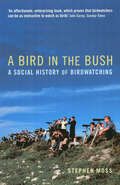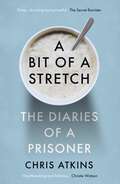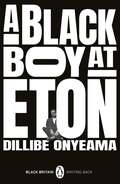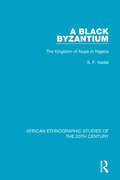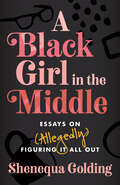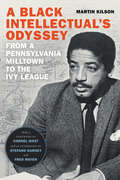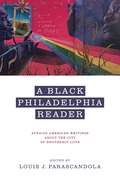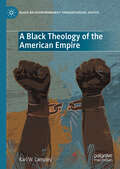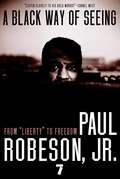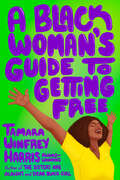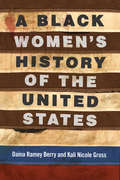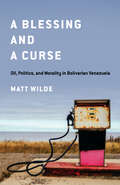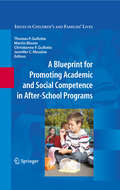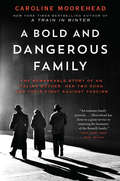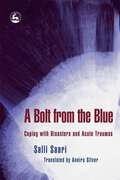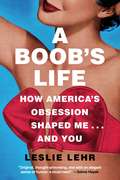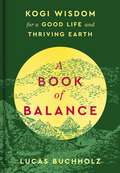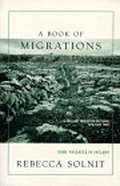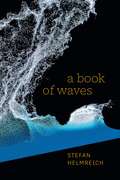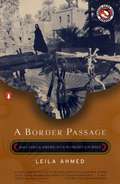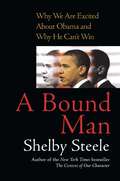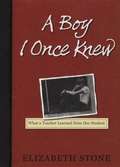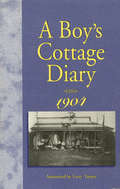- Table View
- List View
A Bird in the Bush: A Social History of Birdwatching
by Stephen MossThis journey through the world of birdwatchers is “a wonderful book. . . . fascinating, often hilarious anecdotes and information” (Daily Mail, Critic’s Choice).Scholarly, authoritative, and above all supremely readable, Stephen Moss’s book is the first to trace the fascinating history of how and why people have watched birds for pleasure, from the beginnings with Gilbert White in the eighteenth century through World War II POWs watching birds from inside their prison camp and all the way to today’s “twitchers” with their bleeping pagers, driving hundreds of miles for a rare bird.“Proves that birdwatchers can be as instructive to watch as birds.” —Sunday Times“Thoroughly researched and well-written.” —The Guardian“Moss knows his subject intimately and writes about it with just the right mixture of affection and occasional quizzicality.” —Sunday Telegraph“It would be difficult to imagine anyone producing a more comprehensive, thoughtful, intelligent and entertaining examination of how people have watched birds at each point in history. In fact, it is one of the few books which might prove such compulsive reading that even a dedicated twitcher might forgo a day in the field to stay at home to finish it.” —Birding World
A Bit of a Stretch: The Diaries of a Prisoner
by Chris Atkins'Shocking, scathing, entertaining.' Guardian 'Incredibly compelling.' The Times'Heart-breaking.' Sunday TimesWhere can a tin of tuna buy you clean clothes? Where is it easier to get 'spice' than paracetamol? Where does self-harm barely raise an eyebrow?Welcome to Her Majesty's Prison Service. Like most people, documentary-maker Chris Atkins didn't spend much time thinking about prisons. But after becoming embroiled in a dodgy scheme to fund his latest film, he was sent down for five years. His new home would be HMP Wandsworth, one of the largest and most dysfunctional prisons in Europe.With a cast of characters ranging from wily drug dealers to senior officials bent on endless reform, this powerful memoir uncovers the horrifying reality behind the locked gates. Filled with dark humour and shocking stories, A Bit of a Stretch reveals why our creaking prison system is sorely costing us all - and why you should care.
A Black Boy at Eton (Black Britain: Writing Back #11)
by Dillibe Onyeama'The story [Onyeama] had to tell was so gripping and shocking, it wouldn't let me go . . . A remarkably well-written memoir' Bernardine Evaristo, from the IntroductionDillibe was the second black boy to study at Eton - joining in 1965 - and the first to complete his education there. Written at just 21, this is a deeply personal, revelatory account of the racism he endured during his time as a student at the prestigious institution. He tells in vivid detail of his own background as the son of a Nigerian judge at the International Court of Justice at The Hague, of his arrival at the school, of the curriculum, of his reception by other boys (and masters), and of his punishments. He tells, too, of the cruel racial prejudice and his reactions to it, and of the alienation and stereotyping he faced at such a young age. A Black Boy at Eton is a searing, ground-breaking book displaying the deep psychological effects of colonialism and racism.A title in the Black Britain: Writing Back series - selected by Booker Prize-winning author Bernardine Evaristo, this series rediscovers and celebrates pioneering books depicting black Britain that remap the nation.
A Black Byzantium: The Kingdom of Nupe in Nigeria
by S. F. NadelOriginally published in 1942 this now classic book is a study of the Nupe of Northern Nigeria. The economic and political complexity of their kingdom evoked comparisons with the civilization of Byzantium. The detailed description and analysis of their social life and political institutions was the first study of a Muslim Emirate in Nigeria and as such is still an indispensable work.
A Black Girl in the Middle: Essays on (Allegedly) Figuring It All Out
by Shenequa GoldingA blazingly honest essay collection from a refreshing new voice exploring the in-between moments for Black women and girls, and what it means to simply exist&“At thirty-seven years old I can say Shenequa is a big name and I&’m a big, bold woman.&”Shenequa Golding doesn&’t aim to speak for all Black women. We&’re too vast, too vibrant, and too complicated. As an adult, Golding begins to own her boldness, but growing up, she found herself &“kind of in the middle,&” fluctuating between not being the fly kid or the overachiever. Her debut collection of essays, A Black Girl in the Middle taps into life&’s wins and losses, representing the middle ground for Black girls and women.Golding packs humor, curiosity, honesty, anger, and ultimately acceptance in 12 essays spanning her life in Queens, NY, as a first generation Jamaican American. She breaks down the 10 levels of Black Girl Math, from the hard glare to responses reserved for unfaithful boyfriends. She comes to terms with and heals from fraught relationships with her father, friends, and romantic partners. She takes the devastating news that she&’s a Black girl with a &“flat ass&” in stride, and adds squats to her routine, eventually. From a harrowing encounter in a hotel room leading her to explore celibacy (for now) to embracing rather than fearing the &“Milli Vanilli&” of emotions in hurt and anger, Golding embraces everything she&’s learned with wit, heart, and humility. A Black Girl in the Middle is both an acknowledgment of the complexity and pride of not always fitting in and validation of what Black girlhood and womanhood can be.
A Black Intellectual's Odyssey: From a Pennsylvania Milltown to the Ivy League
by Martin KilsonIn 1969, Martin Kilson became the first tenured African American professor at Harvard University, where he taught African and African American politics for over thirty years. In A Black Intellectual's Odyssey, Kilson takes readers on a fascinating journey from his upbringing in the small Pennsylvania milltown of Ambler to his experiences attending Lincoln University—the country's oldest HBCU—to pursuing graduate study at Harvard before spending his entire career there as a faculty member. This is as much a story of his travels from the racist margins of twentieth-century America to one of the nation's most prestigious institutions as it is a portrait of the places that shaped him.He gives a sweeping sociological tour of Ambler as a multiethnic, working-class company town while sketching the social, economic, and racial elements that marked everyday life. From narrating the area's history of persistent racism and the racial politics in the integrated schools to describing the Black church's role in buttressing the town's small Black community, Kilson vividly renders his experience of northern small-town life during the 1930s and 1940s.At Lincoln University, Kilson's liberal political views coalesced as he became active in the local NAACP chapter. While at Lincoln and during his graduate work at Harvard, Kilson observed how class, political, and racial dynamics influenced his peers' political engagement, diverse career paths, and relationships with white people. As a young professor, Kilson made a point of assisting Harvard's African American students in adapting to life at a white institution.Throughout his career, Kilson engaged in pioneering scholarship while mentoring countless students. A Black Intellectual's Odyssey features contributions from three of his students: a foreword by Cornel West and an afterword by Stefano Harney and Fred Moten.
A Black Philadelphia Reader: African American Writings About the City of Brotherly Love
by Louis J. ParascandolaThe relationship between the City of Brotherly Love and its Black residents has been complicated from the city’s founding through the present day. A Black Philadelphia Reader traces this complex history in the words of Black writers who were native to, lived in, or had significant connections to the city. Featuring the works of famous authors—including W. E. B. Du Bois, Harriet Jacobs, Sonia Sanchez and John Edgar Wideman—alongside lesser-known voices, this reader is an immersive and enriching composite portrait of the Black experience in Philadelphia. Through fiction and nonfiction, poetry and prose, readers witness episodes of racial prejudice and gender inequality in areas like public health, housing, education, policing, criminal justice, and public transportation. And yet amid these myriad challenges, the writers convey an enduring faith, a love of family and community, and a hope that Philadelphia will fulfill its promises to its Black citizens.Thoughtfully introduced and accompanied by notes that contextualize the works and aid readers’ comprehension, this book will appeal to a wide audience of Philadelphians and other readers interested in American, African American, and urban studies.
A Black Theology of the American Empire (Black Religion/Womanist Thought/Social Justice)
by Karl W. LampleyThis book understands, interprets, and critiques the theology of the American Empire that undergirds and bolsters U.S. foreign policy and global engagement in the contemporary world order. It is particularly in conversation with African American experience, American presidential history, black religious and political thought, as well as black theological perspectives. The book makes a constructive theological statement and declaration on the American Empire in opposition and resistance to racism and white supremacy in U.S. origins and historical development. Finally it proposes a way forward for twenty-first century black theology in response to the foundational theology of James Cone. This publication is important, not only for scholars interested in black religious thought, but also those seeking critical reflection on the omnipresence of racial inequality and social injustice in the American Empire.
A Black Way of Seeing: From "Liberty" to Freedom
by Paul RobesonIn the tradition of James Baldwin's Notes of a Native Son, Robeson's A Black Way of Seeing melds history and analysis in a sweeping panorama of the present moment as we know it to be--scathing in its understanding of why Black empowerment has failed and prescient in its articulation of what it will take for Black Americans to be agents of change for the country as a whole.
A Black Woman's Guide to Getting Free
by Tamara Winfrey HarrisEmpowering, feminist guidance for Black women on living unapologetically and authentically-from the bestselling author of The Sisters Are Alright.Unshackle your authentic self from the expectations and stereotypes of American culture through the 6 pillars of living free as a Black woman.Tamara Winfrey Harris harnesses her knowledge as a two-time author and storyteller of the Black femme experience and nationally known expert on the intersections of race and gender to deliver a sharp feminist analysis that is illustrated by real-life stories and examples plucked from popular culture and intimate Black woman-to-Black woman truth-telling.This book is separated into two parts. First, the meaning of liberation is explored and Black women will be guided in creating sustaining practice to mature their well-being along the freedom journey. In part two, readers are introduced to the 6 pillars of living free as a Black woman: Spot the distortionsKnow your truthCelebrate the real youUnderstand the cost of liberationPractice freedomSEE free Black women everywhereWith the bold, astute writing that you have come to expect from Winfrey-Harris, A Black Woman's Guide to Getting Free urges Black women everywhere to choose themselves, and choose freedom, in a world that would have you chained.
A Black Women's History of the United States (REVISIONING HISTORY #5)
by Daina Ramey Berry Kali Nicole GrossA vibrant and empowering history that emphasizes the perspectives and stories of African American women to show how they are--and have always been--instrumental in shaping our country <P><P>In centering Black women's stories, two award-winning historians seek both to empower African American women and to show their allies that Black women's unique ability to make their own communities while combatting centuries of oppression is an essential component in our continued resistance to systemic racism and sexism. Daina Ramey Berry and Kali Nicole Gross offer an examination and celebration of Black womanhood, beginning with the first African women who arrived in what became the United States to African American women of today. <P><P>A Black Women's History of the United States reaches far beyond a single narrative to showcase Black women's lives in all their fraught complexities. Berry and Gross prioritize many voices: enslaved women, freedwomen, religious leaders, artists, queer women, activists, and women who lived outside the law. The result is a starting point for exploring Black women's history and a testament to the beauty, richness, rhythm, tragedy, heartbreak, rage, and enduring love that abounds in the spirit of Black women in communities throughout the nation.
A Blessing and a Curse: Oil, Politics, and Morality in Bolivarian Venezuela
by Matt WildeA Blessing and a Curse examines the lived experience of political change, moral uncertainty, and economic crisis amid Venezuela's controversial Bolivarian Revolution. Drawing on ethnographic research conducted in an urban barrio over the course of a decade, Matt Wilde argues that everyday life in this period was intimately shaped by a critical contradiction: that in their efforts to capture a larger portion of oil money and distribute it more widely among the population, the governments of Hugo Chávez and Nicolás Maduro pursued policies that ultimately entrenched Venezuela in the very position of dependency they sought to overcome. Offering a new synthesis between anthropological work on energy, politics, and morality, the book explores how the use of oil money to fund the revolution's social programs and political reforms produced profound cultural anxieties about the contaminating effects of petroleum revenues in everyday settings. Tracing how these anxieties rippled out into community life, family networks, and local politics, Wilde shows how questions about how to live a good life came to be intimately shaped by Venezuela's contradictory relationship with oil. In doing so, he brings a vital perspective to contemporary debates about energy transitions by proposing a new way of thinking about the political and moral economies of natural resources in postcolonial settings.
A Blueprint for Promoting Academic and Social Competence in After-School Programs (Issues in Children's and Families' Lives #10)
by Thomas P. Gullotta Martin Bloom Jennifer C. Messina Christianne F. GullottaSchool activities alone are not always sufficient to ensure children's academic progress or socio-emotional development and well-being. And the time when many children typically have the least adult supervision - immediately after school - is also the time that they are at the highest risk to act as perpetrators or become victims of antisocial behavior. Throughout A Blueprint for Promoting Academic and Social Competence in After-School Programs, which focuses on children in grades 1 through 6, noted experts identify the best practices of effective programs and pinpoint methods for enhancing school-based skills and making them portable to home and neighborhood settings. This volume: (1) Analyzes the concepts central to effective after-school programs. (2) Offers developmental, cognitive, and social ecology perspectives on how children learn. (3) Features more than 100 exercises that develop young people's capabilities for academic, social, moral, and emotional learning - These exercises are ready to use or can be adapted to students' unique needs. (4) Emphasizes young people's development as students and as productive members of society during middle to late childhood and early adolescence. (5) Presents explicit theory and evidence that can be used to explain the value of after-school programs for budget proposals. This important book will find an appreciative, ready audience among the program directors who design after-school curricula, the educators who implement them, the mental health and social work professionals who help staff them, and the current crop of graduate students who will create the next generation of programs.
A Bold and Dangerous Family: The Remarkable Story of an Italian Mother, Her Two Sons, and Their Fight Against Fascism
by Caroline MooreheadThe acclaimed author of A Train in Winter and Village of Secrets delivers the next chapter in "The Resistance Quartet": the astonishing story of the aristocratic Italian family who stood up to Mussolini's fascism, and whose efforts helped define the path of Italy in the years between the World Wars—a profile in courage that remains relevant today.Members of the cosmopolitan, cultural aristocracy of Florence at the beginning of the twentieth century, the Rosselli family, led by their fierce matriarch, Amelia, were vocal anti-fascists. As populist, right-wing nationalism swept across Europe after World War I, and Italy’s Prime Minister, Benito Mussolini, began consolidating his power, Amelia’s sons Carlo and Nello led the opposition, taking a public stand against Il Duce that few others in their elite class dared risk. When Mussolini established a terrifying and brutal police state controlled by his Blackshirts—the squaddristi—the Rossellis and their anti-fascist circle were transformed into active resisters.In retaliation, many of the anti-fascists were arrested and imprisoned; others left the country to escape a similar fate. Tragically, Carlo and Nello were eventually assassinated by Mussolini’s secret service. After Italy entered World War II in June 1940, Amelia, thanks to visas arranged by First Lady Eleanor Roosevelt herself, fled to New York City with the remaining members of her family.Renowned historian Caroline Moorehead paints an indelible picture of Italy in the first half of the twentieth century, offering an intimate account of the rise of Il Duce and his squaddristi; life in Mussolini’s penal colonies; the shocking ambivalence and complicity of many prominent Italian families seduced by Mussolini’s promises; and the bold, fractured resistance movement whose associates sacrificed their lives to fight fascism. In A Bold and Dangerous Family, Moorehead once again pays tribute to heroes who fought to uphold our humanity during one of history’s darkest chapters. A Bold and Dangerous Family is illustrated with black-and-white photographs.
A Bolt from the Blue: Coping with Disasters and Acute Traumas
by Annira Silver Salli Saari'Saari's book discusses the impact of traumatic events and the key principles underlying acute crisis work. Case study examples are used to illustrate the main features of traumatic situations and ways of processing such experiences, as well as the practical implications for crisis support.' - Bereavement Care, Volume 26, April 2007 'The book provides a basic introduction to trauma and will be an interesting initial read for those new to this field.' - Bereavement Care, Volume 26, April 2007 'What this well written book brings is a coherent understanding of the possible effects upon us as those involved first hand, as a relative/friend of someone involved, as an observer either close by or at a distance via television or other media. I think this book offers therapists, clients, and policy makers a view of how to deal with those "bolts from the blue" with more understanding of the nature of trauma and its effects upon the individual and the community. The author has put together a book that looks at the processing of a traumatic event, the effects of it upon adults and children, how to work with a traumatised person, and the impact of interventions upon the individual.' - British Psychodrama Association Journal 'The thought I am left with after reading this book is that a basic grounding in psychological first aid should be a vital part of the "tools" of all who work in the helping professions and as a necessary part of every modern citizen's education, as is medical "first aid". - Therapy Today 'Saari examines in detail the psychological effects of traumatic events on individuals. She explains each step of the process of recovery, from the initial through lingering effects that follow the return to everyday life. The importance pf psycho-social support is also addressed. The final chapter is devoted to an examination of the efficacy of single-session debriefing in preventing traumatization.' - Book News 'This is an accessible introductory text that attempts to consider a range of issues related to personal responses to traumatic events. The author is an experienced Finnish Psychologist who obviously has extensive experience in the field of crisis response and acute trauma.' - Mental Health Practice In the wake of a number of large-scale disasters in recent years, the world is all too aware of crises but largely underprepared for the psychological repercussions of traumatic events on victims and recovery staff. Salli Saari examines in detail the psychological effect traumatic events can have on an individual, taking the reader step-by-step through each stage of the process of understanding and recovery. She also discusses the role of social support, the media and the workplace in addressing trauma, and what methods can be adopted to help victims cope after a traumatic incident. Based on work within the Finnish organized crisis care network, A Bolt from the Blue shows how crisis care can be an integral part of health care services, covering all traumatic incidents from a death in the family to major accidents and disasters. This book is an essential text for any professional who comes into contact with people affected by a traumatic experience, including psychologists, counsellors, medical doctors, social workers, nurses, pastoral carers/clergy, and students in these fields. It is also accessible enough to be of use to laymen who have encountered a traumatic experience and may need help.
A Bomb in Every Issue
by Peter RichardsonA Mother Jones "Best Book of 2009," A Bomb in Every Issue uncovers the largely untold story of Ramparts magazine, the spectacular San Francisco muckraker that captured the zeitgeist of the '60s and repeatedly scooped the New York Times, changing American journalism forever.Launched in 1962 as a Catholic literary quarterly, Ramparts quickly transformed into a "radical slick," winning a George Polk Award in 1967 for its "explosive revival of the great muckraking tradition." According to the Los Angeles Times, the magazine "not only blew the cover off the biggest stories of the era, it also helped set the ideological agenda for its core demographic, the New Left, and forced the mainstream press to follow its lead."Ramparts' list of contributors--including Noam Chomsky, César Chávez, Seymour Hersh, Angela Davis, and Susan Sontag--formed a who's who of the American left. Although Ramparts folded for good in 1975, former staffers founded Rolling Stone and Mother Jones and include some of the most illustrious names in journalism (names like Robert Scheer, Jann Wenner, and Warren Hinckle), and Ramparts remains an inspiration to investigative journalists today.
A Bomb in Every Issue
by Peter RichardsonA Mother Jones "Best Book of 2009," A Bomb in Every Issue uncovers the largely untold story of Ramparts magazine, the spectacular San Francisco muckraker that captured the zeitgeist of the '60s and repeatedly scooped the New York Times, changing American journalism forever.Launched in 1962 as a Catholic literary quarterly, Ramparts quickly transformed into a "radical slick," winning a George Polk Award in 1967 for its "explosive revival of the great muckraking tradition." According to the Los Angeles Times, the magazine "not only blew the cover off the biggest stories of the era, it also helped set the ideological agenda for its core demographic, the New Left, and forced the mainstream press to follow its lead."Ramparts' list of contributors--including Noam Chomsky, César Chávez, Seymour Hersh, Angela Davis, and Susan Sontag--formed a who's who of the American left. Although Ramparts folded for good in 1975, former staffers founded Rolling Stone and Mother Jones and include some of the most illustrious names in journalism (names like Robert Scheer, Jann Wenner, and Warren Hinckle), and Ramparts remains an inspiration to investigative journalists today.
A Boob's Life: How America's Obsession Shaped Me—and You
by Leslie LehrA Boob&’s Life explores the surprising truth about women&’s most popular body part with vulnerable, witty frankness and true nuggets of American culture that will resonate with everyone who has breasts—or loves them.Author Leslie Lehr wants to talk about boobs. She&’s gone from size AA to DDD and everything between, from puberty to motherhood, enhancement to cancer, and beyond. And she&’s not alone—these are classic life stages for women today. At turns funny and heartbreaking, A Boob&’s Life explores both the joys and hazards inherent to living in a woman&’s body. Lehr deftly blends her personal narrative with national history, starting in the 1960s with the women&’s liberation movement and moving to the current feminist dialogue and what it means to be a woman. Her insightful and clever writing analyzes how America&’s obsession with the female form has affected her own life&’s journey and the psyche of all women today. From her prize-winning fiction to her viral New York Times Modern Love essay, exploring the challenges facing contemporary women has been Lehr&’s life-long passion. A Boob&’s Life, her first project since breast cancer treatment, continues this mission, taking readers on a wildly informative, deeply personal, and utterly relatable journey. No matter your gender, you&’ll never view this sexy and sacred body part the same way again.
A Book of Balance: Kogi Wisdom for a Good Life and Thriving Earth
by Lucas BuchholzWe all need help centering ourselves to serve ourselves and our world. In this small, beautiful book, the Kogi—a remote and ancient tribe in the mountains of Colombia--offer their learnings. They pose nine thought-provoking questions to help us live harmoniously with the earth and in turn find happiness and purpose in every moment.“Just as we are both sitting here and talking, this is how we can live well. All of this you will write in the book.”—Mama Jose Gabriel, a spiritual guide of the Kogi tribe, to author Lucas BuchholzFor centuries, the Kogi have lived in seclusion in Colombia’s remote Sierra Nevadas, known as “the heart of the world.” But in recent years, concerned by the environmental degradation they have experienced in their villages and forests, a few emissaries from the tribe emerged to bring an urgent and loving message to the West—advice on how to live in harmony with the earth.Buchholz was invited to their home to receive and transcribe this message. A Book of Balance takes us on a journey into a startlingly beautiful landscape and into a sacred space: the traditional fireside circle held regularly by the tribe. In this circle, members consider key questions essential to their community.In this slim volume of spiritual introspection, they ask us to share in their practice, posing nine questions that focus our minds and hearts on who we are, who we can become.Throughout we hear the words of the Kogi elders, wisdom that offers revelations, inspiration, and direction for our everyday lives.A beautiful book to own, to share with friends, and discuss in community.
A Book of Migrations: Some Passages in Ireland
by Rebecca SolnitTravel and history intermingle in this elegant reflection on identity and memory. In her journey through Ireland, author Rebecca Solnit portrays in microcosm a history made up of great tides of invasion, colonization, emigration, nomadism, and tourism. Her observations carve a new route through Ireland's history, literature, and landscape.
A Book of Waves (The Lewis Henry Morgan Lectures)
by Stefan HelmreichIn A Book of Waves Stefan Helmreich examines ocean waves as forms of media that carry ecological, geopolitical, and climatological news about our planet. Drawing on ethnographic work with oceanographers and coastal engineers in the Netherlands, the United States, Australia, Japan, and Bangladesh, Helmreich details how scientists at sea and in the lab apprehend waves’ materiality through abstractions, seeking to capture in technical language these avatars of nature at once periodic and irreversible, wild and pacific, ephemeral and eternal. For researchers and their publics, the meanings of waves also reflect visions of the ocean as an environmental infrastructure fundamental to trade, travel, warfare, humanitarian rescue, recreation, and managing sea level rise. Interleaving ethnographic chapters with reflections on waves in mythology, surf culture, feminist theory, film, Indigenous Pacific activisms, Black Atlantic history, cosmology, and more, Helmreich demonstrates how waves mark out the wakes and breaks of social histories and futures.
A Border Passage: From Cairo to America--A Woman's Journey
by Leila AhmedA memoir of the author's life and understanding of her identity
A Bound Man
by Shelby SteeleIn Shelby Steele's beautifully wrought and thoughtprovoking new book, A Bound Man, the award-winning and bestselling author of The Content of Our Character attests that Senator Barack Obama's groundbreaking quest for the highest office in the land is fast becoming a galvanizing occasion beyond mere presidential politics, one that is forcing a national dialogue on the current state of race relations in America. Says Steele, poverty and inequality usually are the focus of such dialogues, but Obama's bid for so high an office pushes the conversation to a more abstract level where race is a politics of guilt and innocence generated by our painful racial history -- a kind of morality play between (and within) the races in which innocence is power and guilt is impotence. Steele writes of how Obama is caught between the two classic postures that blacks have always used to make their way in the white American mainstream: bargaining and challenging. Bargainers strike a "bargain" with white America in which they say, I will not rub America's ugly history of racism in your face if you will not hold my race against me. Challengers do the opposite of bargainers. They charge whites with inherent racism and then demand that they prove themselves innocent by supporting black-friendly policies like affirmative action and diversity. Steele maintains that Senator Obama is too constrained by these elaborate politics to find his own true political voice. Obama has the temperament, intelligence, and background -- an interracial family, a sterling education -- to guide America beyond the exhausted racial politics that now prevail. And yet he is a Promethean figure, a bound man. Says Steele, Americans are constrained by a racial correctness so totalitarian that we are afraid even to privately ask ourselves what we think about racial matters. Like Obama, most of us find it easier to program ourselves for correctness rather than risk knowing and expressing what we truly feel. Obama emerges as a kind of Everyman in whom we can see our own struggle to accept and honor what we honestly feel about race. In A Bound Man, Steele makes clear the precise constellation of forces that bind Senator Obama, and proposes a way for him to break these bonds and find his own voice.The courage to trust in one's own careful judgment is the new racial progress, the "way out" from the forces that now bind us all.
A Boy I Once Knew: What a Teacher Learned from Her Student
by Elizabeth StoneIn 1995 Elizabeth Stone received an unexpected gift - a carton of notebooks, the journals of a former high-school student named Vincent. Dying of AIDS at the age of forty, Vincent willed his diaries to his former ninth-grade teacher, asking her to turn his life into a book. Stone weaves her own life story through excerpts from Vincent's diaries. As Vincent comes to terms with the deaths of friends and with his own approaching end, Stone is helped to make her own peace with loss and death as a part of life.
A Boy's Cottage Diary, 1904
by Fred Dickinson Larry TurnerFred Dickinson’s diary opens a window on youth and the world of Ontario lakeland cottages at the beginning of the 20th century."The stories we hand down, the diaries we preserve become the fabric of our social history. Young Fred Dickinson’s 1904 account of tenting and cottaging is a spirited first-hand sketch of a long-neglected part of our heritage. Larry Turner places the diary within social, historic and geographic contexts giving it wide appeal to history buffs of all ages …."- Julie Johnston, award-winning author
